Oil catch can with turbo application
#76
Honda-Tech Member
Thread Starter
Join Date: Apr 2009
Location: MASSDRIVEN
Posts: 190
Likes: 0
Received 0 Likes
on
0 Posts
One end of the his can did not go to the intake tube. It went to the top of the air filter. There's a big difference. The intake tube will be at vacuum when the engine is running. The top of the air filter will have very little if any. Ever unplug a vacuum hose off the intake tube of a car and feel the suction there? Pretty strong. Every put your fingers by the air filter? nada. That's because the air flowing in is spread out over such a large surface area and he picked the very top plate of the air filter.
If there was to much timing and the motor was pinging the plugs should give that away. As well as pistons when he gets to inspect them. You'd think a motor pinging bad enough to destroy itself in 5 hours of normal non boost driving would have been noticeable but I'm not sure. I've never had a motor ping and then just drive it to its death so I really have no time scale as to how long it takes to kill it.
If there was to much timing and the motor was pinging the plugs should give that away. As well as pistons when he gets to inspect them. You'd think a motor pinging bad enough to destroy itself in 5 hours of normal non boost driving would have been noticeable but I'm not sure. I've never had a motor ping and then just drive it to its death so I really have no time scale as to how long it takes to kill it.
#77
Honda-Tech Member
oh it's probably not the reason. it's just you could improve it by either running a vented unit or plumbing to a couple inches in front of the turbo for the vacuum effect.
#78
Honda-Tech Member
Thread Starter
Join Date: Apr 2009
Location: MASSDRIVEN
Posts: 190
Likes: 0
Received 0 Likes
on
0 Posts
yeah. the whole thing is, i was told that when i was making the system. but i tested the vac pressure with a one way check valve. and i was getting good suction with the inlet being on the center plate of the air filter. doesnt seem like it would create enough but it was. i think im just going to trash the whole system i got and buy that can kit on page 1. put it all back together and hammer it.
#79
Honda-Tech Member
i don't think that would hurt but it's likely not the reason for your problem. also, you could modify what you have easily by doing a cut out then welding a small circle of aluminum to the top of the can for a filter to clamp on to. you could use the two nipples present for the VC and black box
or, an even easier way would be to buy that allstar catchcan from amazon for $67 bucks. it's a first class piece with dual inlets and a large filter surface area
or, an even easier way would be to buy that allstar catchcan from amazon for $67 bucks. it's a first class piece with dual inlets and a large filter surface area
#81
Hey all. First post here and I know the thread is old, but wanted to contribute to it.
First for those wanting to know my qualifications:
Automotive engineer
over 38 years building rce and performance engines & vehicles
trained at Reher Morrision racing engines as well as several other well known race engine shops
owned, managed, raced proffesionally for years (drag racing, no experiance road racing).
Current, past drivers plus myself hold numerous Divisonal, National, and World Championships in both NHRA & IHRA in multiple classes (star driver Peter Biondo currently one of only two drivers in NHRA history to win 6 diff classes in National Championships tied with Jeg Coughlin, Jr.)
Most recent wins both Super Gas and Super Stock at Bristol this June, World in SuperGas at Pomona last year.
On to the subject:
(bear in mind that this was written for mainly V8's, but I-4's are no dofferent)
The PCV system is one of the most misunderstood on cars and light trucks today, and as I read through these threads I see it continues.
Some history on the function and progression of the PCV system to what we see today:
In the "old days" of our grandfathers, the engineers that designed engines new the importance of evacuating these nasty compounds and the design was extremely simple. First was nothing more than plain breathers to allow excess crankcase pressure to be released or vented. But the damage from not "flushing" all the gasses out resulted in very short engine life (of course the oils of that day were nothing like the protection today's synthetics provide) so the next change added a vent tube, or evacuation tube that ran from the top of the crankcase to low on the car where the air streaming past would create a suction, or vacuum that would pull the vapors out and vent them directly into the air with a breather (barely filtered with a wire mesh type media that was oiled to catch dust & dirt) allowing the "fresh" makeup air in to complete the flushing process. Now this resulted in greatly increased engine life, but as the motors got worn oil would start to drip out the tube and drip onto the roadways, then the rain would wash it into the ditches, where it would enter the ground water (you know the rest of the EPA story) and the gasses just vented to the air.
As the EPA and the powers that be mandated stricter emission laws the system was refined more and more ultimately evolving into what we have today. A completely sealed system that uses the vacuum provided by the intake manifold to draw these vapors out, and the filtered fresh makeup air is drawn from the main air intake system and filtered by the main air filter. This results in very clean emissions, but the unintended issues are the detonation or "knock" that occurs when oil is introduced into the combustion chamber that the knock sensors pick up (before we can hear it) and pull timing to protect the engine from damage, and thus reduced power. Another result is the carbon buildup on the valves & piston tops (any techs reading this can surely verify the amount) also resulting in decreased performance and less power made.
Understanding oil contamination from combustion byproducts
The evac system is not for the environment....it is to keep the engine alive and wear free as long as
possible. Your not alone and 99% of car owners never think about it or realize whats happening over
time. And yes, most will drive 50-75-100k plus miles and never know the damage gradually being
done.
Now on to how this applies to todays FI motors or modified NA motors:
Every motor has a certain amount of blow-by, the bigger the CI & the more boost the more blow-by
(with everything else assumed is equal and no piston/ring/cylinder issue).
Most only look at the crankcase pressure portion and deal with that and that is only a small part of the
crankcase evac systems function. The most important is the flushing & removal of the harmful
combustion products before they have a chance to condense & settle into the crankcase oil.
These consist of:
Unburnt fuel
Carbon monoxide
water vapor
carbon particles
and several other harmful compounds that when mixed in the crankcase produce Sulfuric acid and as
that accumulates past a certain PPM the bearing surfaces, wrist pins, and crank journals begin to be
etched and start to damage. This is gradual of course so thatís why like you, most never realize whats
happening.
The other very harmful byproduct is the very abrasive carbon particles (near diamond-like in
abrasiveness) that many are to small to be caught by the oil filter and accelerate wear as well.
If you have a good cross flow of filtered fresh air entering one side of the crankcase (best is through a
flow controlled breather), say the pass side oil fill cap, that fresh air will travel through the pass side
valve cover, around the rockers, down the pushrod valley, through the center of the crankcase, (now on
the LS6/2/3 valley cover with the fixed orifice it exits there drawn by vacuum so 1/2 the engine is still
stagnant with foul compounds...especially the drivers side rocker area) up the drivers side pushrod
valley, past the rockers and exits the rear of the drivers side valve cover flushing and pulling the
compounds out BEFORE they can settle and condense into the crankcase. Now with out that flow the
compounds settle and mix with the oil every time the engine cools. When started and run to operating
temp the volatile of those are "flashed off" and again could be evacuated but if just venting with
breathers, ONLY the excess crankcase pressure will exit and very little of the harmful compound mix
goes with it and once the abrasive carbon particles mix with the oil they are there to stay reducing the
protection your oil provides. Now if changing your oil after every track event then this is not an issue.
But with a street driven car it is and I can tell you to just look at how dirt your oil gets as far as
coloration when you eliminate the evacuation portion of a PCV system, but that tells very little. Send in
an oil sample to a good analysis lab and the report back will verify everything I'm saying. The over the
road trucking industry does this as a rule, and we do with our race engines as well looking for metal
content that tells us a bearing is going away before we could ever detect it and knowing to freshen
before a catastrophic failure.
Now we come to the issue of FI builds that pressurize the intake manifold. Turbo or front mount centri
SC systems, the problem with the OEM style system is as soon as you are under boost and the intake is
under positive atmosphere you are pressurizing the crankcase directly via the vacuum nipple that evacs
under non boost.
The only true solution for street driven cars is a oil separating crankcase evac system that will provide
proper, continuous evac while operating under non-boost via the intake vacuum, and as soon as it
senses pressurization a check valve senses this and closes blocking any chance of crankcase
pressurization. Then as this happens a secondary valve opens and uses the suction/vacuum of the head
unit to continue evacuation while the separating can traps & removes all the oil in suspension allowing
only the gasses that do not effect the energy released per explosive event (you do NOT want ANY oil
entering the intake air charge or residue/varnish forming on the compressor wheels throwing them off
balance).
No oil caused detonation, no shortened engine life/increased wear, and the best of everything you need
for the motor to perform properly & last as long as possible.
Now, on to what I am seeing here. As with most tuners, the misconception is only relieving crankcase pressure and the visable condensation.
Every system I see in use here is breaking the evac system and ONLY venting pressure. As explained above, unless you are changing oil every few weeks or are not concerned with premature wear of your internals, you must evac. Also, if you are reintroducing the trapped oil to the crankcase you are bringing in highly contaminated oil with high concentrations of the damaging compounds explained above. NEVER throw dirt into an engine crankcase! And even though that is an extreme comparison, for a motor you have pride and money in I'm sure most would be alarmed to know what your puuting back in the crankcase.
Now, ANY can will catch oil...thats the nature of condensing any liquid from a vapor. The issue is most are no more than empty cans w/2 fittings and the ones with media have issues in pull through.
Here are some examples:
Yes...just the same as a beer can w/two fittings:
Here are pictures of that companies can inside....an empty can that the vapors enter one fitting and u-turn right out w/out a chance to coalesce and condense the oil trapping it through a series of baffels, filters, and chambers:
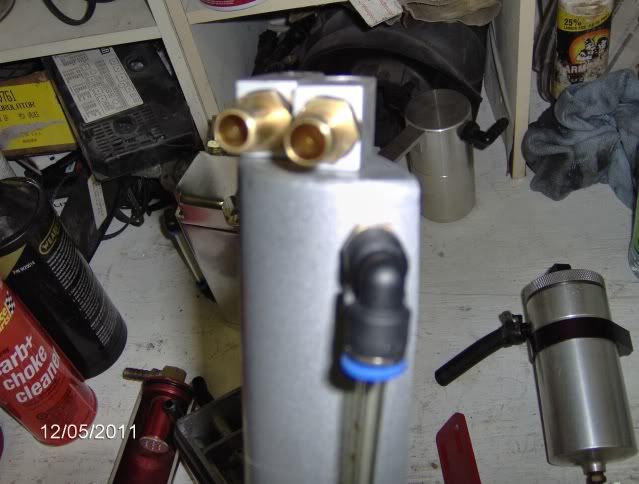
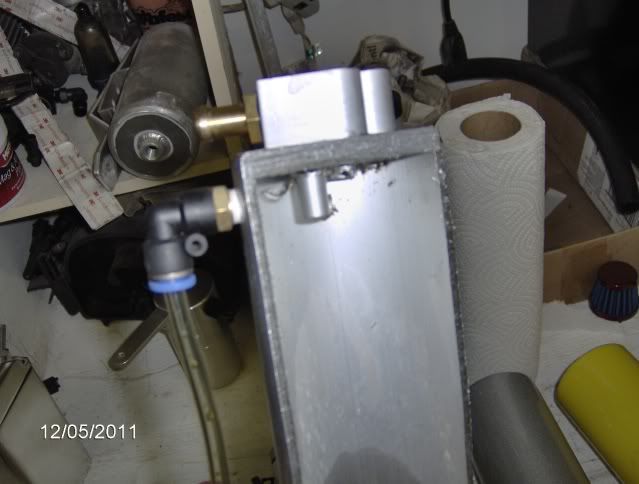
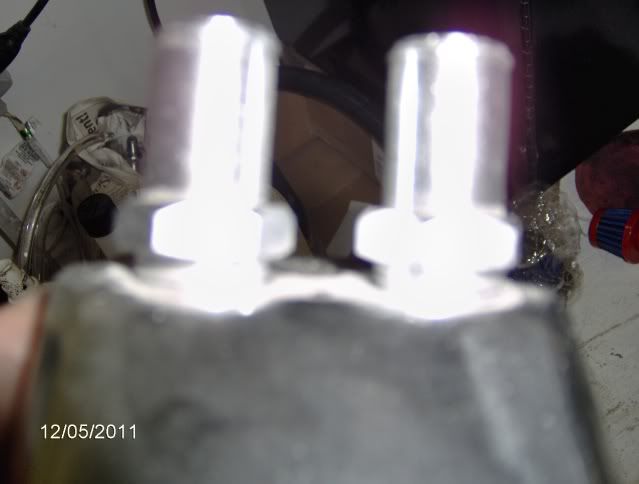

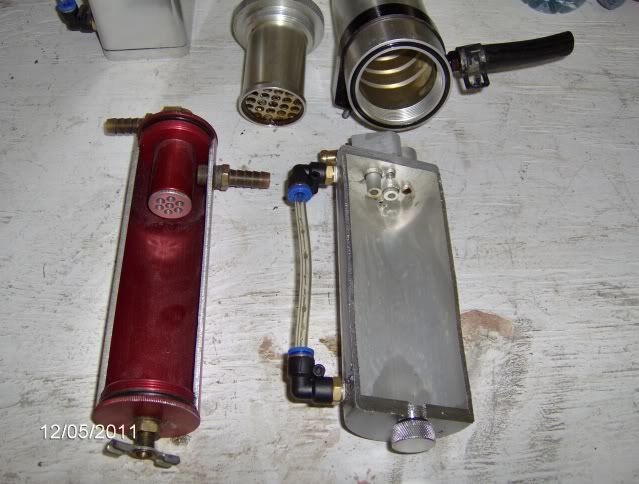
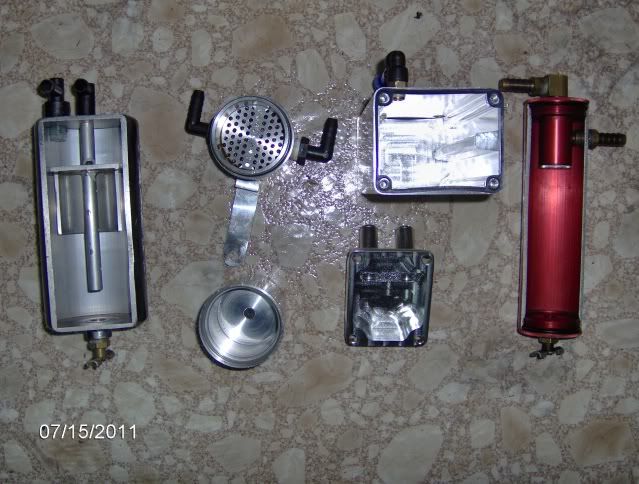
Most cans allow 50-70% of the oil to still pass right through the can so even though your catching oil, you have only addressed part of the issue.
Above, the early RX can is far left...more baffels and coalscing material is in the current versions. Catches 98-99% of the oil.
Next is the Moroso, billet prototypes, Diablosport, etc. can.
High priced, excelent machined and high quality but since it is so small it does not allow the flow to slow enough to let all oil drop out of suspension and has no designated inlet or outlet so the side used as the outlet traps oil right at the outlet allowing 30-40% to pull through (take a wet wash cloth, suck on it and water pulls through).
Then a typical EBay empty can, then the Mike Norris/CCVA/catchcans.com unit that functions quite well with the only issues being the droplets falling out of the filter chamber are to close to the outlet so app 20% gets sucked through, but excellent can compared to 99%.
The cans that work the best are in this order (you can test any can your self to see....dont take my word for it. Simply buy a cheap clear galss inline fuel filter between the intake vacuum barb and any can outlet. Poor cans will saturate the filter in 100 miles or less.) :
RX can and the Sakou Micchi catch 98-99% in most cases, the Saikou Micchi has no intergrated check valves and only coalescing material inside, no separte chambers, but is large enough to really do an excellent job.
AMW & Elite engineering. Both very similar design...catch 90-95% of oil. Only flaw is small size allows some pull through. Excellent cans.
Mike Norris/CCA/catchcans.com. Catch 80% plus, but outlet right at exit from coalsecing chamber so some pull through.
Below is the RX can:
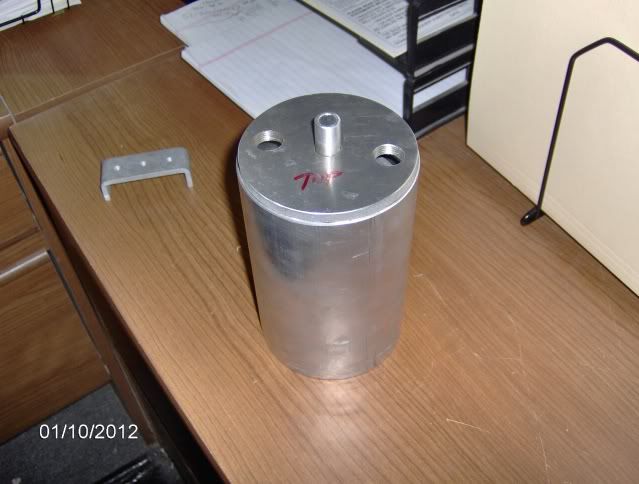
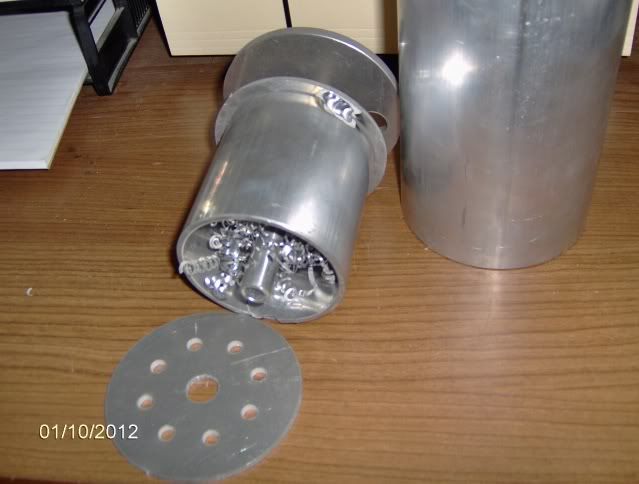
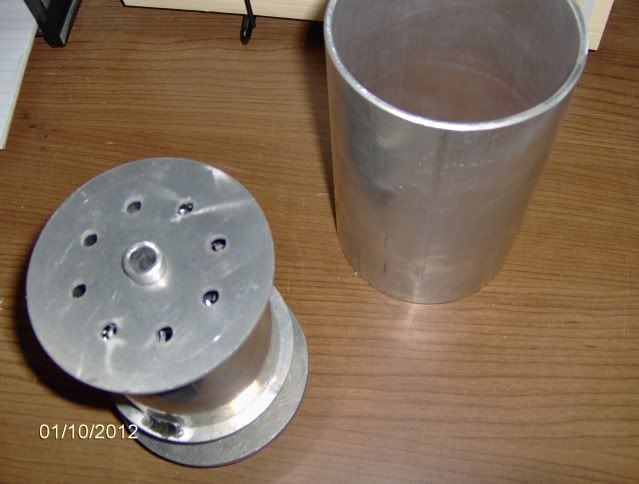
Vapors enter the top center tube, travel pst the separate outlet chamber into a coalseing chamber where a perforated dispersion tube evenly disperses the vapors into the media, then out the bottom into the condesing and collection chamber, then up the outer wall past a disc baffel into the separate outlet chamber, and exiting the one way flow controlling checkvalves.
The primary outer valve uses the IM vac when in non boost operation to evac, then closes when it detects boost and the secondary outlet valve opens using the inlet side of the turbo for suction so no matter what operation your in, boost or non boost you have consant crankcase evac and 99% oil separation. System remains closed so 50 state emmission compliant if used with checkvalved metered flow breather.
Long enough post for now.....ask questions in detail and I will answer them in detail. Take the time to ask intelligent questions in detail please. This is the most misunderstood system on FI applications today.....and this should make a good public disscussions to address the misconceptions, and I want no fight with any vendor....I'm not here to sell anything or take away anything, just share a lifetime (in my late 50's) of automotive engineering and super charging since the early 70's and turbo's since the late 70's and the lifetime of championship drag racing from all aspects.
:thumbsup:
First for those wanting to know my qualifications:
Automotive engineer
over 38 years building rce and performance engines & vehicles
trained at Reher Morrision racing engines as well as several other well known race engine shops
owned, managed, raced proffesionally for years (drag racing, no experiance road racing).
Current, past drivers plus myself hold numerous Divisonal, National, and World Championships in both NHRA & IHRA in multiple classes (star driver Peter Biondo currently one of only two drivers in NHRA history to win 6 diff classes in National Championships tied with Jeg Coughlin, Jr.)
Most recent wins both Super Gas and Super Stock at Bristol this June, World in SuperGas at Pomona last year.
On to the subject:
(bear in mind that this was written for mainly V8's, but I-4's are no dofferent)
The PCV system is one of the most misunderstood on cars and light trucks today, and as I read through these threads I see it continues.
Some history on the function and progression of the PCV system to what we see today:
In the "old days" of our grandfathers, the engineers that designed engines new the importance of evacuating these nasty compounds and the design was extremely simple. First was nothing more than plain breathers to allow excess crankcase pressure to be released or vented. But the damage from not "flushing" all the gasses out resulted in very short engine life (of course the oils of that day were nothing like the protection today's synthetics provide) so the next change added a vent tube, or evacuation tube that ran from the top of the crankcase to low on the car where the air streaming past would create a suction, or vacuum that would pull the vapors out and vent them directly into the air with a breather (barely filtered with a wire mesh type media that was oiled to catch dust & dirt) allowing the "fresh" makeup air in to complete the flushing process. Now this resulted in greatly increased engine life, but as the motors got worn oil would start to drip out the tube and drip onto the roadways, then the rain would wash it into the ditches, where it would enter the ground water (you know the rest of the EPA story) and the gasses just vented to the air.
As the EPA and the powers that be mandated stricter emission laws the system was refined more and more ultimately evolving into what we have today. A completely sealed system that uses the vacuum provided by the intake manifold to draw these vapors out, and the filtered fresh makeup air is drawn from the main air intake system and filtered by the main air filter. This results in very clean emissions, but the unintended issues are the detonation or "knock" that occurs when oil is introduced into the combustion chamber that the knock sensors pick up (before we can hear it) and pull timing to protect the engine from damage, and thus reduced power. Another result is the carbon buildup on the valves & piston tops (any techs reading this can surely verify the amount) also resulting in decreased performance and less power made.
Understanding oil contamination from combustion byproducts
The evac system is not for the environment....it is to keep the engine alive and wear free as long as
possible. Your not alone and 99% of car owners never think about it or realize whats happening over
time. And yes, most will drive 50-75-100k plus miles and never know the damage gradually being
done.
Now on to how this applies to todays FI motors or modified NA motors:
Every motor has a certain amount of blow-by, the bigger the CI & the more boost the more blow-by
(with everything else assumed is equal and no piston/ring/cylinder issue).
Most only look at the crankcase pressure portion and deal with that and that is only a small part of the
crankcase evac systems function. The most important is the flushing & removal of the harmful
combustion products before they have a chance to condense & settle into the crankcase oil.
These consist of:
Unburnt fuel
Carbon monoxide
water vapor
carbon particles
and several other harmful compounds that when mixed in the crankcase produce Sulfuric acid and as
that accumulates past a certain PPM the bearing surfaces, wrist pins, and crank journals begin to be
etched and start to damage. This is gradual of course so thatís why like you, most never realize whats
happening.
The other very harmful byproduct is the very abrasive carbon particles (near diamond-like in
abrasiveness) that many are to small to be caught by the oil filter and accelerate wear as well.
If you have a good cross flow of filtered fresh air entering one side of the crankcase (best is through a
flow controlled breather), say the pass side oil fill cap, that fresh air will travel through the pass side
valve cover, around the rockers, down the pushrod valley, through the center of the crankcase, (now on
the LS6/2/3 valley cover with the fixed orifice it exits there drawn by vacuum so 1/2 the engine is still
stagnant with foul compounds...especially the drivers side rocker area) up the drivers side pushrod
valley, past the rockers and exits the rear of the drivers side valve cover flushing and pulling the
compounds out BEFORE they can settle and condense into the crankcase. Now with out that flow the
compounds settle and mix with the oil every time the engine cools. When started and run to operating
temp the volatile of those are "flashed off" and again could be evacuated but if just venting with
breathers, ONLY the excess crankcase pressure will exit and very little of the harmful compound mix
goes with it and once the abrasive carbon particles mix with the oil they are there to stay reducing the
protection your oil provides. Now if changing your oil after every track event then this is not an issue.
But with a street driven car it is and I can tell you to just look at how dirt your oil gets as far as
coloration when you eliminate the evacuation portion of a PCV system, but that tells very little. Send in
an oil sample to a good analysis lab and the report back will verify everything I'm saying. The over the
road trucking industry does this as a rule, and we do with our race engines as well looking for metal
content that tells us a bearing is going away before we could ever detect it and knowing to freshen
before a catastrophic failure.
Now we come to the issue of FI builds that pressurize the intake manifold. Turbo or front mount centri
SC systems, the problem with the OEM style system is as soon as you are under boost and the intake is
under positive atmosphere you are pressurizing the crankcase directly via the vacuum nipple that evacs
under non boost.
The only true solution for street driven cars is a oil separating crankcase evac system that will provide
proper, continuous evac while operating under non-boost via the intake vacuum, and as soon as it
senses pressurization a check valve senses this and closes blocking any chance of crankcase
pressurization. Then as this happens a secondary valve opens and uses the suction/vacuum of the head
unit to continue evacuation while the separating can traps & removes all the oil in suspension allowing
only the gasses that do not effect the energy released per explosive event (you do NOT want ANY oil
entering the intake air charge or residue/varnish forming on the compressor wheels throwing them off
balance).
No oil caused detonation, no shortened engine life/increased wear, and the best of everything you need
for the motor to perform properly & last as long as possible.
Now, on to what I am seeing here. As with most tuners, the misconception is only relieving crankcase pressure and the visable condensation.
Every system I see in use here is breaking the evac system and ONLY venting pressure. As explained above, unless you are changing oil every few weeks or are not concerned with premature wear of your internals, you must evac. Also, if you are reintroducing the trapped oil to the crankcase you are bringing in highly contaminated oil with high concentrations of the damaging compounds explained above. NEVER throw dirt into an engine crankcase! And even though that is an extreme comparison, for a motor you have pride and money in I'm sure most would be alarmed to know what your puuting back in the crankcase.
Now, ANY can will catch oil...thats the nature of condensing any liquid from a vapor. The issue is most are no more than empty cans w/2 fittings and the ones with media have issues in pull through.
Here are some examples:
Yes...just the same as a beer can w/two fittings:
Here are pictures of that companies can inside....an empty can that the vapors enter one fitting and u-turn right out w/out a chance to coalesce and condense the oil trapping it through a series of baffels, filters, and chambers:






Most cans allow 50-70% of the oil to still pass right through the can so even though your catching oil, you have only addressed part of the issue.
Above, the early RX can is far left...more baffels and coalscing material is in the current versions. Catches 98-99% of the oil.
Next is the Moroso, billet prototypes, Diablosport, etc. can.
High priced, excelent machined and high quality but since it is so small it does not allow the flow to slow enough to let all oil drop out of suspension and has no designated inlet or outlet so the side used as the outlet traps oil right at the outlet allowing 30-40% to pull through (take a wet wash cloth, suck on it and water pulls through).
Then a typical EBay empty can, then the Mike Norris/CCVA/catchcans.com unit that functions quite well with the only issues being the droplets falling out of the filter chamber are to close to the outlet so app 20% gets sucked through, but excellent can compared to 99%.
The cans that work the best are in this order (you can test any can your self to see....dont take my word for it. Simply buy a cheap clear galss inline fuel filter between the intake vacuum barb and any can outlet. Poor cans will saturate the filter in 100 miles or less.) :
RX can and the Sakou Micchi catch 98-99% in most cases, the Saikou Micchi has no intergrated check valves and only coalescing material inside, no separte chambers, but is large enough to really do an excellent job.
AMW & Elite engineering. Both very similar design...catch 90-95% of oil. Only flaw is small size allows some pull through. Excellent cans.
Mike Norris/CCA/catchcans.com. Catch 80% plus, but outlet right at exit from coalsecing chamber so some pull through.
Below is the RX can:



Vapors enter the top center tube, travel pst the separate outlet chamber into a coalseing chamber where a perforated dispersion tube evenly disperses the vapors into the media, then out the bottom into the condesing and collection chamber, then up the outer wall past a disc baffel into the separate outlet chamber, and exiting the one way flow controlling checkvalves.
The primary outer valve uses the IM vac when in non boost operation to evac, then closes when it detects boost and the secondary outlet valve opens using the inlet side of the turbo for suction so no matter what operation your in, boost or non boost you have consant crankcase evac and 99% oil separation. System remains closed so 50 state emmission compliant if used with checkvalved metered flow breather.
Long enough post for now.....ask questions in detail and I will answer them in detail. Take the time to ask intelligent questions in detail please. This is the most misunderstood system on FI applications today.....and this should make a good public disscussions to address the misconceptions, and I want no fight with any vendor....I'm not here to sell anything or take away anything, just share a lifetime (in my late 50's) of automotive engineering and super charging since the early 70's and turbo's since the late 70's and the lifetime of championship drag racing from all aspects.
:thumbsup:
#83
Honda-Tech Member
SC2150 I read your post with great interest and agree on why we have the PCV system.
When I built my turbo'd civic I attempted to keep it pulling air out by using a check valve that would shut when the car goes into boost. I used a quick opening brass check valve I got from McMaster-Carr.com
http://www.mcmaster.com/#standard-check-valves/=j8xhxl (top right hand side valves).
You can see it in the pic below over here. It's on the right side coming off the intake manifold

I put an extra hole in the valve cover in addition to the factory hole and have a breather on both with a catch can. The idea was in normal driving air would be drawn in by engine vacuum through my check valve which runs to the stock PCV valve location on the back of the block and draws air through the block & valve cover and my breathers on top.
Then under boost my check valve closes and stops boost from blowing into the crank case. Any pressure build up in the crank case will blow out the valve cover holes into my catch can and as soon as I goes out of boost air will travel back the other way as drawn in by engine vacuum.
It was all great in theory. The reality I ran into was the volume of air sucking through my valve cover breathers and through my check valve and into the intake manifold was to much. This caused the car to idle really high (I think it was around 1500 ~ 1800 rpms) so I never got a chance to actually use that system. I ended up removing the check valve and just putting breathers on as I know I should not
I have yet to re-visit this and come up with a proper solution that draws air through the system in normal driving without having the high idle problem.
When I built my turbo'd civic I attempted to keep it pulling air out by using a check valve that would shut when the car goes into boost. I used a quick opening brass check valve I got from McMaster-Carr.com
http://www.mcmaster.com/#standard-check-valves/=j8xhxl (top right hand side valves).
You can see it in the pic below over here. It's on the right side coming off the intake manifold

I put an extra hole in the valve cover in addition to the factory hole and have a breather on both with a catch can. The idea was in normal driving air would be drawn in by engine vacuum through my check valve which runs to the stock PCV valve location on the back of the block and draws air through the block & valve cover and my breathers on top.
Then under boost my check valve closes and stops boost from blowing into the crank case. Any pressure build up in the crank case will blow out the valve cover holes into my catch can and as soon as I goes out of boost air will travel back the other way as drawn in by engine vacuum.
It was all great in theory. The reality I ran into was the volume of air sucking through my valve cover breathers and through my check valve and into the intake manifold was to much. This caused the car to idle really high (I think it was around 1500 ~ 1800 rpms) so I never got a chance to actually use that system. I ended up removing the check valve and just putting breathers on as I know I should not

I have yet to re-visit this and come up with a proper solution that draws air through the system in normal driving without having the high idle problem.
#84
Honda-Tech Member
Thread Starter
Join Date: Apr 2009
Location: MASSDRIVEN
Posts: 190
Likes: 0
Received 0 Likes
on
0 Posts
im not sure where the extra hole in the im is that your talking about... the check valve is a good idea, the problem would only be where the crank pressure is venting too. do you have that line with the check valve going back into the block or is that the line comes from the can.... its hard to tell in your discription. And yes i had this problem i found, the easyest way to deal with this problem is to run your lines off of the vc into the can, off the black bock on the block and into the vc. It is alos benificial to have a return line from the bottom of the catch can, to one of the factory ports on the back of the block. I have some pictures of this i will try to upload when im home.
#85
You were on the right track, but most checkvalves (the one you link to) will not meter the flow so you were pulling excess air in and it had the same effect as a vacuum leak.
We only use flow controlling valves that are calibrated to the crankcase size and CI of the engine and then the issue is non existant. We also do the same on the clean side breather and use an integrated flow controlling checkvalve to prevent excess flow that can cause fuel trims to go crazy.
Let me know and I can have you test a system on your build to give feedback. I think you will be surprised.
I cant answer PM's as I am limited yet being a new member but feel free to email me direct: tlewis4095@aol.com
On returning the contaminated oil to the crankcase that will result in increased engine component wear. There is a ton of damaging compunds trapped in any can with the oil. abrasive carbon particles and sulfuric acid do the most damage.
Take the oil trapped from any can and send it in for an oil analysis and see for yourself. Nasty stuff.
:thumb:
We only use flow controlling valves that are calibrated to the crankcase size and CI of the engine and then the issue is non existant. We also do the same on the clean side breather and use an integrated flow controlling checkvalve to prevent excess flow that can cause fuel trims to go crazy.
Let me know and I can have you test a system on your build to give feedback. I think you will be surprised.
I cant answer PM's as I am limited yet being a new member but feel free to email me direct: tlewis4095@aol.com
On returning the contaminated oil to the crankcase that will result in increased engine component wear. There is a ton of damaging compunds trapped in any can with the oil. abrasive carbon particles and sulfuric acid do the most damage.
Take the oil trapped from any can and send it in for an oil analysis and see for yourself. Nasty stuff.
:thumb:
#86
Who is Mr Robot?
iTrader: (2)
Join Date: Jul 2004
Location: ATL - Where the Pimps and Players dwell
Posts: 21,474
Likes: 0
Received 10 Likes
on
10 Posts
why did you bump this? theres a massive thread devoted to this very topic... not some piddly *** tiny thread that died.
goddamn noobs
goddamn noobs
#87
Honda-Tech Member
ive been running my vc line and the rear black box line to the bottom of my car. no catch can just straight down for 2 years never had a problem.
#88
Honda-Tech Member
You were on the right track, but most checkvalves (the one you link to) will not meter the flow so you were pulling excess air in and it had the same effect as a vacuum leak.
We only use flow controlling valves that are calibrated to the crankcase size and CI of the engine and then the issue is non existant. We also do the same on the clean side breather and use an integrated flow controlling checkvalve to prevent excess flow that can cause fuel trims to go crazy.
Let me know and I can have you test a system on your build to give feedback. I think you will be surprised.
I cant answer PM's as I am limited yet being a new member but feel free to email me direct: tlewis4095@aol.com
On returning the contaminated oil to the crankcase that will result in increased engine component wear. There is a ton of damaging compunds trapped in any can with the oil. abrasive carbon particles and sulfuric acid do the most damage.
Take the oil trapped from any can and send it in for an oil analysis and see for yourself. Nasty stuff.
:thumb:
We only use flow controlling valves that are calibrated to the crankcase size and CI of the engine and then the issue is non existant. We also do the same on the clean side breather and use an integrated flow controlling checkvalve to prevent excess flow that can cause fuel trims to go crazy.
Let me know and I can have you test a system on your build to give feedback. I think you will be surprised.
I cant answer PM's as I am limited yet being a new member but feel free to email me direct: tlewis4095@aol.com
On returning the contaminated oil to the crankcase that will result in increased engine component wear. There is a ton of damaging compunds trapped in any can with the oil. abrasive carbon particles and sulfuric acid do the most damage.
Take the oil trapped from any can and send it in for an oil analysis and see for yourself. Nasty stuff.
:thumb:
#89
Retired Moderator
iTrader: (8)
The primary outer valve uses the IM vac when in non boost operation to evac, then closes when it detects boost and the secondary outlet valve opens using the inlet side of the turbo for suction so no matter what operation your in, boost or non boost you have consant crankcase evac and 99% oil separation. System remains closed so 50 state emmission compliant if used with checkvalved metered flow breather.
Maybe i missed something when reading that novel...
Also, most boosted hondas dont have any tube or place to put a vac source pre-turbo. Its mostly just a filter on the inlet.
#90
I can send you a flow controlling valve. A fixed orfice does not vary but will accomplish the same.
As for the combustionbyproducts, they are damaging in the crankcase oil....but as long as the oil is removed they have no effect burning in the combustion process. The crankcase oil and the combustion chamber.process are totally separate.
They have no effect on the turbo as they are in a suspended or gasseous state. The oil is another issue as it bakes on to the turbine blades and throws them off balance as well as the detonation the oil causes in the combustion chamber.
Take some motor oil and pour a bit in a bowl and try to light it on fire....it dosent burn unless extreme heat and or under pressure and then it is a very incomplete burn.
You only want air/fuel mixture in the combustion chamber (and the evacuated combustion byproducts that burn and pass through no problem).
Where they cause damage is in the engine oil after they have settled if not evacuated while still in a suspended or gasseous state.
Think about it. surfuric acid etches the bearing surfaces and crank journals (can be seen as spots when tear down is done), the carbon particles are as abrasive as anything except diamonds...and the particles that pass the rings are to small for the filter to trap so these need to be evacuated while still supended and before the engine cools after shutdown and they condense and settle into the oil.
A filter on the turbo inlet will still work as long as you attache at the base, but it is far better to have some length of tube before the filter to realize enough vacuum to be effective.
As for the combustionbyproducts, they are damaging in the crankcase oil....but as long as the oil is removed they have no effect burning in the combustion process. The crankcase oil and the combustion chamber.process are totally separate.
They have no effect on the turbo as they are in a suspended or gasseous state. The oil is another issue as it bakes on to the turbine blades and throws them off balance as well as the detonation the oil causes in the combustion chamber.
Take some motor oil and pour a bit in a bowl and try to light it on fire....it dosent burn unless extreme heat and or under pressure and then it is a very incomplete burn.
You only want air/fuel mixture in the combustion chamber (and the evacuated combustion byproducts that burn and pass through no problem).
Where they cause damage is in the engine oil after they have settled if not evacuated while still in a suspended or gasseous state.
Think about it. surfuric acid etches the bearing surfaces and crank journals (can be seen as spots when tear down is done), the carbon particles are as abrasive as anything except diamonds...and the particles that pass the rings are to small for the filter to trap so these need to be evacuated while still supended and before the engine cools after shutdown and they condense and settle into the oil.
A filter on the turbo inlet will still work as long as you attache at the base, but it is far better to have some length of tube before the filter to realize enough vacuum to be effective.
#91
Honda-Tech Member
I can send you a flow controlling valve. A fixed orfice does not vary but will accomplish the same.
As for the combustionbyproducts, they are damaging in the crankcase oil....but as long as the oil is removed they have no effect burning in the combustion process. The crankcase oil and the combustion chamber.process are totally separate.
They have no effect on the turbo as they are in a suspended or gasseous state. The oil is another issue as it bakes on to the turbine blades and throws them off balance as well as the detonation the oil causes in the combustion chamber.
Take some motor oil and pour a bit in a bowl and try to light it on fire....it dosent burn unless extreme heat and or under pressure and then it is a very incomplete burn.
You only want air/fuel mixture in the combustion chamber (and the evacuated combustion byproducts that burn and pass through no problem).
Where they cause damage is in the engine oil after they have settled if not evacuated while still in a suspended or gasseous state.
Think about it. surfuric acid etches the bearing surfaces and crank journals (can be seen as spots when tear down is done), the carbon particles are as abrasive as anything except diamonds...and the particles that pass the rings are to small for the filter to trap so these need to be evacuated while still supended and before the engine cools after shutdown and they condense and settle into the oil.
A filter on the turbo inlet will still work as long as you attache at the base, but it is far better to have some length of tube before the filter to realize enough vacuum to be effective.
As for the combustionbyproducts, they are damaging in the crankcase oil....but as long as the oil is removed they have no effect burning in the combustion process. The crankcase oil and the combustion chamber.process are totally separate.
They have no effect on the turbo as they are in a suspended or gasseous state. The oil is another issue as it bakes on to the turbine blades and throws them off balance as well as the detonation the oil causes in the combustion chamber.
Take some motor oil and pour a bit in a bowl and try to light it on fire....it dosent burn unless extreme heat and or under pressure and then it is a very incomplete burn.
You only want air/fuel mixture in the combustion chamber (and the evacuated combustion byproducts that burn and pass through no problem).
Where they cause damage is in the engine oil after they have settled if not evacuated while still in a suspended or gasseous state.
Think about it. surfuric acid etches the bearing surfaces and crank journals (can be seen as spots when tear down is done), the carbon particles are as abrasive as anything except diamonds...and the particles that pass the rings are to small for the filter to trap so these need to be evacuated while still supended and before the engine cools after shutdown and they condense and settle into the oil.
A filter on the turbo inlet will still work as long as you attache at the base, but it is far better to have some length of tube before the filter to realize enough vacuum to be effective.
Also how do they control flow? What do they base it on? engine rpm, amount of vacuum etc? interested to learn more.
#92
Honda-Tech Member
Join Date: Aug 2009
Location: Baton Rouge,Louisiana
Posts: 7,635
Likes: 0
Received 3 Likes
on
3 Posts
Most catchcan setups I've done, including my own do not have a drain back. They vent the back of the block, if allowed. The two nipples on the back of the block are ran to a catch can, that has a vent on top, and 2 inlets. Honda motors, in general are pretty bad about building up high rpm crank case pressure, on some blocks u can actually vent the crank case itself, others have to vent from the valvecover, depends on the motor really..
What is your thought on this?
Basically there are two vents on the back of the block, venting those into a baffled can seems smart, without a drain back.. i dont believe in drain back neither.
What is your thought on this?
Basically there are two vents on the back of the block, venting those into a baffled can seems smart, without a drain back.. i dont believe in drain back neither.
Thread
Thread Starter
Forum
Replies
Last Post
AlphaKennyWun
Forced Induction
8
10-04-2004 12:47 PM



